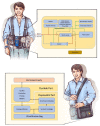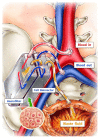Artificial Kidney Engineering: The Development of Dialysis Membranes for Blood Purification
- PMID: 35207097
- PMCID: PMC8876607
- DOI: 10.3390/membranes12020177
Artificial Kidney Engineering: The Development of Dialysis Membranes for Blood Purification
Abstract
The artificial kidney, one of the greatest medical inventions in the 20th century, has saved innumerable lives with end stage renal disease. Designs of artificial kidney evolved dramatically in decades of development. A hollow-fibered membrane with well controlled blood and dialysate flow became the major design of the modern artificial kidney. Although they have been well established to prolong patients' lives, the modern blood purification system is still imperfect. Patient's quality of life, complications, and lack of metabolic functions are shortcomings of current blood purification treatment. The direction of future artificial kidneys is toward miniaturization, better biocompatibility, and providing metabolic functions. Studies and trials of silicon nanopore membranes, tissue engineering for renal cell bioreactors, and dialysate regeneration are all under development to overcome the shortcomings of current artificial kidneys. With all these advancements, wearable or implantable artificial kidneys will be achievable.
Keywords: REDY system; artificial kidney; cell bioreactor; implantable artificial kidney; nanopore silicon membrane; wearable artificial kidney.
Conflict of interest statement
The authors declare no conflict of interest.
Figures




Similar articles
-
From portable dialysis to a bioengineered kidney.Expert Rev Med Devices. 2018 May;15(5):323-336. doi: 10.1080/17434440.2018.1462697. Epub 2018 Apr 20. Expert Rev Med Devices. 2018. PMID: 29633900 Review.
-
Feasibility of an implantable bioreactor for renal cell therapy using silicon nanopore membranes.Nat Commun. 2023 Aug 29;14(1):4890. doi: 10.1038/s41467-023-39888-2. Nat Commun. 2023. PMID: 37644033 Free PMC article.
-
Innovations in Wearable and Implantable Artificial Kidneys.Am J Kidney Dis. 2018 Nov;72(5):745-751. doi: 10.1053/j.ajkd.2018.06.005. Epub 2018 Aug 23. Am J Kidney Dis. 2018. PMID: 30146422 Review.
-
The future of the artificial kidney: moving towards wearable and miniaturized devices.Nefrologia. 2011;31(1):9-16. doi: 10.3265/Nefrologia.pre2010.Nov.10758. Nefrologia. 2011. PMID: 21270908 Review.
-
Wearable and implantable artificial kidney devices for end-stage kidney disease treatment: Current status and review.Artif Organs. 2023 Apr;47(4):649-666. doi: 10.1111/aor.14396. Epub 2022 Sep 21. Artif Organs. 2023. PMID: 36129158 Review.
Cited by
-
Transportable, portable, wearable and (partially) implantable haemodialysis systems: comparison of technologies and readiness levels.Clin Kidney J. 2024 Aug 24;17(9):sfae259. doi: 10.1093/ckj/sfae259. eCollection 2024 Sep. Clin Kidney J. 2024. PMID: 39301271 Free PMC article. Review.
-
Hydrophilic Modification of Dialysis Membranes Sustains Middle Molecule Removal and Filtration Characteristics.Membranes (Basel). 2024 Apr 3;14(4):83. doi: 10.3390/membranes14040083. Membranes (Basel). 2024. PMID: 38668111 Free PMC article.
-
A new era in the science and care of kidney diseases.Nat Rev Nephrol. 2024 Jul;20(7):460-472. doi: 10.1038/s41581-024-00828-y. Epub 2024 Apr 4. Nat Rev Nephrol. 2024. PMID: 38575770 Review.
-
3D porous structure imaging of membranes for medical devices using scanning probe microscopy and electron microscopy: from membrane science points of view.J Artif Organs. 2024 Jun;27(2):83-90. doi: 10.1007/s10047-023-01431-x. Epub 2024 Feb 5. J Artif Organs. 2024. PMID: 38311666 Review.
-
Portable, wearable and implantable artificial kidney systems: needs, opportunities and challenges.Nat Rev Nephrol. 2023 Aug;19(8):481-490. doi: 10.1038/s41581-023-00726-9. Epub 2023 Jun 5. Nat Rev Nephrol. 2023. PMID: 37277461 Free PMC article. Review.
References
-
- Über H.G. On Blood Washing. Klin Wochenschr. 1928;7:1356–1362.
-
- E Macneill A., E Doyle J., Anthone R., Anthone S. Technic with Parallel Flow, Straight Tube Blood Dialyzer. N. Y. State J. Med. 1959;59:4137–4149. - PubMed
Publication types
LinkOut - more resources
Full Text Sources

